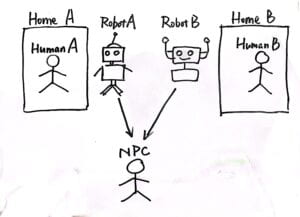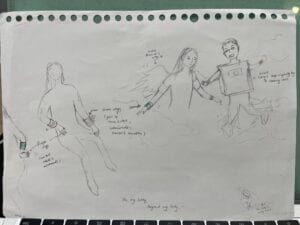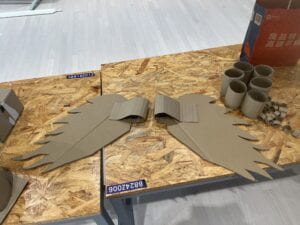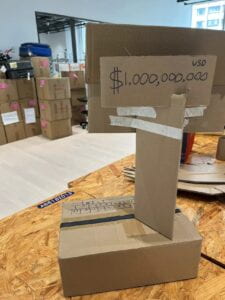
Project:
Our interactive group project is a system of robotics designed to perform tasks for human beings who are required to socially distance from each other due to a pandemic. Our project involves two human beings, two robots controlled by humans via two sets of control systems, and an NPC who “user tests” the robots in virtual but practical scenarios.
In this documentation blog, I will share how we came up with this idea, how we implemented our conceptual ideas with physical prototypes, and what reflections we had on this project after receiving constructive feedback from our instructors and peers, as well as any relevant materials. I will also provide feedback for a performance from another group.
How We Made It Happen:
Step One: Prepare and Connect
The project started with the assignment of teams from Interaction Lab instructors. After being notified of the grouping information, we reached out to each other by email and then agreed to set up a WeChat group chat for instant communication purposes. My teammates (Gerry, Ziyan, Ziyi, and Monica) and I decided to arrange two meetings, with one of them online as a brainstorming session and the other one meeting in person to fabricate the artifact collaboratively. Our project was then officially kick-started.
Step Two: Brainstorm Ideas
Our group members met over Zoom for this part. First, we exchanged our understandings of the prompt and attempted to find commonalities in our definitions of “interaction”. Then, to formulate our own ideas, we created a Google doc and pasted all our work into the “research” and “read” stages so we have a pool of example artifacts to reference. We took turns introducing our thoughts and designs and two repeating key notions stood out to us: “robots” and “control systems“. We also looked at three Sci-Fi stories we read in the second stage of the group project and found that The Plague by Yan Leisheng has provided a feasible virtual context for our tentative artifact: (1) In such an environment where human interactions are highly restricted by the pandemic, it would be practical to utilize robots remotely controlled by humans to perform tasks; (2) This context has provided an analogy to the real life where COVID-19 isolated human connections and technological approaches were applied to keep the world running. These ideas include human-robot interaction, robot-robot interaction and human-human interaction achieved indirectly via robots.
Step Three: Design the Artifact
With the above ideas in mind, we started to design our artifact to operationalize and materialize our conceptions. Our group has five people, so we created five roles/parties of interaction in our artifact. We set the context of our project with reference to Yan Leisheng’s The Plague, where there is a pandemic restricting people to meet each other and infected subjects might get petrified. There are five roles: Human A, Human B, Robot A, Robot B, and an NPC (Non-Player Character, i.e. owner of a bakery).

The above image shows the five parties of our interaction process: Human A and Human B use their control systems (including sensors attached to their hands) to send instructions to their robots, who are expected to work together to perform a task with the involvement of the NPC. Specifically, we collaboratively came up with our storyline: Human A is going to celebrate their birthday and Human B wishes to get Human A a birthday cake, but they are both semi-petrified as one of the plague’s symptoms, therefore needing the assistance of their robots to purchase the cake. Robot A is given a special ability to easily move and transport objects while Robot B is given a special ability to travel fast. Following their owners’ instructions, they collaboratively work together to get the cake from the NPC, a bakery shop owner.
As mentioned, the two human participants are assumed to be semi-petrified, so we designed the sensors to be sensitive enough to detect minor hand movements. Therefore, by moving the wrist and fingers plus audio control, the human participants could easily instruct the movement of their robots to perform complex tasks.
Also, I want to give credit to my group mate Ziyi for sketching this really cool demonstration:

Step Four: Fabricate
After designing the bigger picture and every participant in our project and performance, we listed what we needed to fabricate for the performance:
- Sensors attached to human hands (wrists and fingers);
- Outfit for Robot A
- Outfit for Robot B
- Equipment needed by the NPC
- A cake
Since no electronics are allowed in this project, we mainly used recyclable cardboard to build the above pieces. First, I came up with the idea of how to make hand sensors: I cut the cardboard into medium-sized pieces and rolled them up into a bracelet shape to simulate the wrist part of the sensor; I cut the rest of the trim into smaller regular shapes and rolled them up for the finger part of the sensor. They look like this:
Then Gerry and I worked on Robot A’s outfit with a big box and placed an ironman-like central arc reactor at the heart of the armor.
Other teammates worked on Robot B’s outfit, primarily two wings that demonstrate high mobility. They cut the cardboard into a wing-like shape and added binders to make sure it was wearable on the arms.

As for the NPC gadget, Gerry and I built a cashier machine, a couple of notes as virtual currency, and the others built a cake using rolled-up cardboard.

Step Five: Rehearse and Perform
After fabricating the needed equipment, outfits, and gadgets, we assigned the roles to everyone: Ziyi and Ziyan as humans, Gerry and Monica as robots, and me as the NPC. According to the predetermined storyline, we rehearsed twice and timed our performance in case it went over time. We fixed some design fallacies and improvised our script. Then we met once more before the actual performance on the day and refreshed our memories. Then we performed in the recitation on Friday:
The script of our performance can be found in the Appendix section.
Throughout the project, all of my group members have worked collaboratively and actively. We came up with rough ideas, designs and the performance together and collaboratively fabricated our needed crafts. We were all engaged in the performance and worked on documentation and reflections with the support of each other.
Reflections:
On our project:
I think our project has done a great job of connecting the context and the realistic application of our project. We also have an interesting fusion of cutting-edge technologies and conventional human behaviors., as well as the collaboration between robots when performing special tasks. However, I think we could’ve chosen a task that could help us and the audience generate more thoughts and pondering on human-robot interaction. If doing so, our artifact could urge people to think more about what potential dangers/problems could be foreseen in robots.
On another project:
I was impressed by one of my classmates’ projects using a VR helmet to simulate two interesting settings: the animal fur market and the human meat market. The performance starts with a person walking into an animal fur market and using the provided VR equipment to experience virtual hunting. When the man was in the virtual world relentlessly killing animals, the whole space was flipped into a human meat market with the man trapped, chopped, and sold to the buyers who were the animals just being hunted by the man. The story was relevant to the fictional story The Veldt in terms of the setting and the hunting plots. It meets the assignment criteria quite well with an understanding of the prompt, well-designed and well-made crafts and reflective plots. The group has a complete set of devices and the helmet was fabricated in a detailed way with characteristics of VR technology. The performance, which has clearly highlighted the flip from the animal fur market to the human meat market, sent an alerting message to warn humans’ cruel over-hunting, excessive exploitation of natural resources and disrespect for natural beings. It is a good project, and it could be even better with more emphasis on the “interaction” notion and the feedback received by the human participant.
Appendix:
1. The Performance Script
Ziyan – Human A
Ziyi – Human B
Gerry – Robot A
Monica – Robot B
Kevin – Bakery Owner
[Ziyi and Ziyan are in their own homes, sitting still in their seat.]
Ziyi [Dial the phone with minor finger movements]: Hi Ziyan!
Ziyan: Hi Ziyi!
Ziyi: Ziyan, Happy birthday!
Ziyan: Oh you remember it? Thank you!
Ziyi: Yea… You’re welcome! How are you going to celebrate that?
Ziyan: The pandemic is very bad, so… I don’t want to celebrate it.
Ziyi: Shall we buy a birthday cake?
Ziyan: A birthday cake? But the bakery is pretty far away from here.
Ziyi: Ya… And we have become half statues. When we arrive at the bakery, it’s time to celebrate your million-year-old birthday.
What about our robots? We can ask them to…
Ziyan: Is that realistic?
Ziyi: Well, my robot Monica can fly and take your robot Gerry to the cake shop.
Ziyan: Oh that’s a great idea! Thank you so much.
Ziyi: You’re welcome.
[Kevin is at his bakery]
Ziyi [Dial the phone]
Kevin: Hello, Kevin’s Bakery. Anything I can help you with?
Ziyi: Hi. I want a cake for my friend.
Kevin: Ok, what size and flavor do you want?
Ziyi: 8 inches, cake flavor.
Kevin: Cake flavor cake, that’s a good choice! You can pick it up in 30 minutes.
Ziyi: Thanks, bye.
[At Ziyan’s home: Ziyan called her robot Garry, controlling him through the sensor];
[At Ziyi’s home: Ziyi gave instructions to her robot Monica, controlling Monica to fly to Ziyan’s home]
Ziyi: Monica, Monica!
Monica: Hello~
Ziyi: Take my friend’s robot Garry to the bakery.
Monica: Order copied.
Ziyi: Century Avenue, No. 1555.
Monica: Yes, address copied: Century Avenue, No. 1555.
[With Ziyi’s remote control, Monica flies to Ziyan’s house to pick Garry up. Monica knocks on the door: dang dang dang! ]
Ziyan(to Garry): Open the door, and hold her tightly.
[Garry holds on to Monica’s wings, Monica will bring Garry to the bakery.]
Monica: I won’t stop you if you wanna fall …
Garry: (screaming) AHHH AHHH AHHH AHHH……
[Monica and Garry are at the bakery.]
Kevin: Hi, how can I help you?
Garry: Cake, now!
Kevin: Ok, may I have your telephone number?
Monica: Yes, my host placed the order, with the name Monica and phone number: 12345.
Kevin: Ok, let me see. The cake’s rate is 1 billion in total. Please pay.
Garry: [smash money on the table]
Kevin: Ok, that’s enough.
Monica: [gives Kevin some money] Here are the tips for you.
Kevin: Thank you! [hands the cake to Garry] This is your cake, please enjoy!
[Garry takes the cake and puts it on his head.]
[Monica takes Garry back to Ziyan’s home, but on the way back, Garry drops the cake. Garry picks it up, holding Monica’s wings again, screaming]
[Monica and Garry have arrived at Ziyan’s home.]
Garry: (the robot gives the cake to Ziyan) Cakes for you.
Ziyan: Thank you so much! (To Garry) Go to charge.
Garry: [Kneels down and hides head inside the body.]
Monica: It’s time for me to go back home. [Flies to Ziyi’s home, crouching down and folding her wings.]
[In the bakery, Kevin calls Ziyan, Ziyan receives the call with a tiny finger movement at her home.]
Kevin: Hello, I’m just calling you to make sure you have got the cake.
Ziyan: Oh yeah, I have just received it.
Kevin: Is the cake alright? Because when your robot was at the store, there was something wrong. Could you please check if the quality of the cake is still good?
Ziyan: Yeah, the cake is perfect and the flavor is good.
Kevin: Alright, alright, thank you, thank you! Enjoy it!
Ziyan: Thank you.
Ziyi: [Calls Ziyan] Ding li lingling~
Ziyan:[Answers the phone.]Hello Ziyi.
Ziyi: Have you received the cake?
Ziyan: Yeah, I have received the cake, but it’s a pity that we couldn’t celebrate it together.
Ziyi: Well, what about singing a birthday song together?
Ziyan: Oh, thank you so much!
[Everyone is singing a birthday song together to Ziyan]
Ziyan: Thank you guys!
Leave a Reply